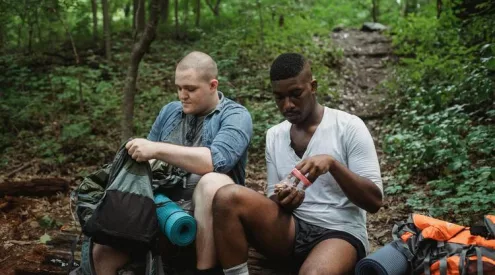Some advice on how not to die when in a lightning storm, after being bitten by a snake or suffering hypothermia.

Survival of the Smartest
Taking people into nature provides them not only with experiences they would never have had before, but also teaches them about responsibility, the importance of a positive attitude, leadership and teamwork.
However, as you never know when you may find yourself in a tricky situation in the great outdoors, here are some guidelines:
When lightning strikes
A count of 3 seconds between a strike and thunder indicates a distance of 1 kilometre. When lightning reaches 3 kilometres away, initiate a lightning drill:
· The most important thing is location, location, location. If you are on high ground, quickly get down to a safer position.
· The ideal place to be is in the open, away from caves, overhangs, trees or metal objects.
· If you’re in a group, spread out to reduce the risk of multiple injuries but stay close enough to maintain communication and visual contact.
· If you have a backpack, sit on it with your ankles together and no part of your body touching the ground.
· Remove all metal objects from your backpack as these can cause serious burns.
When a snake bite isn’t something you order at the bar
Every year, people lose their limbs or lives due to snake bites – often unnecessarily. If you or a friend is bitten by a snake:
· Remain calm. Look and see if the skin is reacting and estimate whether or not poison has entered the body. The victim will become nauseous and dizzy, possibly with blurred vision, if intoxicated by the bite.
· Try to visually identify the snake. If it is definitely a venomous snake there will be intense pain.
- Use a vacuum syringe to try and remove some or all of the venom from the wound
- Wrap a pressure bandage loosely around the area and towards the heart to reduce blood flow – do not use a tourniquet as this may speed tissue damage
- Treat for shock – communicate with the victim, keep their temperature stable and administer CPR if necessary
- Place victim in recovery position
- Monitor vitals
- Get the patient to a doctor
When you’re cold enough to bear more than a passing resemblance to a Smurf
Hypothermia can occur from exposure to low temperatures and is frequently complicated by alcohol.
· Appropriate clothing should be worn on every outing.
· In cold temperatures, occasionally check your lips and nail beds for cyanosis (blue colouring). If they are blue:
o Have a warm drink
o Ensure that you are dry
o Eat a light snack
· For a serious case of hypothermia:
o Get out of wet clothes immediately
o Get into a sleeping bag with a warm person
o Put hot water into bottles and place them into the sleeping bag – to avoid burns, make sure that they don’t touch the skin directly
o Do not try to feed a nearly unconscious person
o Seek medical help
Outward Bound is one of the world’s leading international non-profit experiential education organisations with programmes designed to positively effect change in the lives of disadvantaged people through outdoor activities, with the result being that they complete a programme equipped with life and leadership skills. This in turn enables them to use their new-found confidence to start a career, action a difficult decision, go back to study and re-enter society as contributing citizens. The majority of the Outward Bound courses are aimed at young people but they also offer specialised courses for abused women and children.
Tel 011-467- 8106, www.outwardbound.co.za
Photo by snowpeak

















